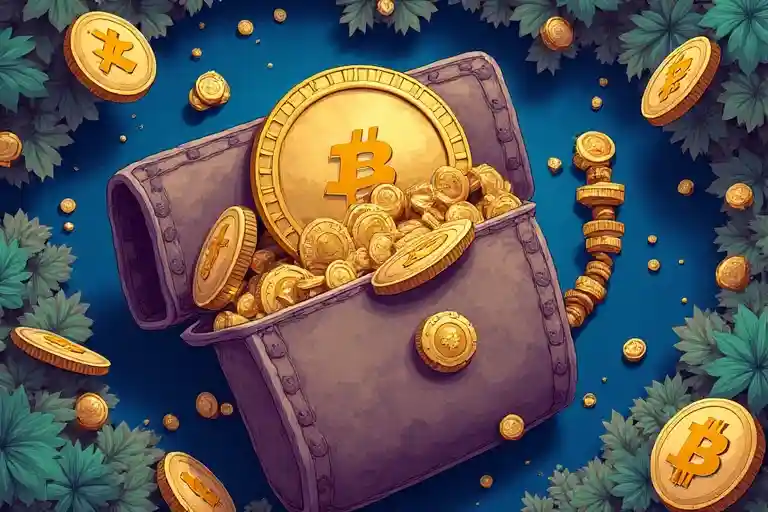Alright, let’s get REAL. You’ve probably heard whispers about “free crypto” floating around on TikTok or your Discord server, and maybe the phrase “faucet crypto trust wallet” popped up. Is it legit? Can you actually get crypto without spending your precious allowance or birthday money? The short answer is… kinda! It’s not like you’re going to become a Bitcoin billionaire overnight (sorry to burst that bubble, like, RIGHT NOW), but crypto faucets can be a cool, super low-risk way to dip your toes into the world of digital currencies, especially when you pair them with a versatile wallet like Trust Wallet. I was pretty skeptical myself at first—free money always sounds a bit sus, right? But after checking it out, it’s more about tiny rewards for simple tasks. Think of it like those mobile games where you watch an ad for a tiny in-game reward, but for crypto! This guide is all about breaking down how faucet crypto trust wallet works, how to stay safe, and how to actually use these things without getting scammed or wasting your time. We’ll cover everything from what these faucets are, setting them up with your Trust Wallet, to figuring out if it’s even worth the effort for a busy teen like you. (Can you believe it?) We’ll also touch on withdrawing those tiny bits of crypto and what other cool stuff you can explore in the crypto space once you get the hang of it. Ready to explore the faucet crypto trust wallet universe? Let’s go!
Last updated: June 2025
What Exactly is a Faucet Crypto Trust Wallet Combo and Why Should You Care?
Okay, so first things first: what *is* a crypto faucet? Imagine a dripping faucet – instead of water, it slowly drips out tiny amounts of cryptocurrency. That’s the basic idea! Crypto faucets are websites or apps that give out small rewards in crypto (like tiny fractions of Bitcoin, Ethereum, or other altcoins) in exchange for completing simple tasks. These tasks can be anything from watching ads, solving CAPTCHAs (you know, those “I’m not a robot” puzzles), taking short quizzes, or even just clicking a button every so often. It’s not a get-rich-quick scheme – seriously, the amounts are usually *microscopic* – but it’s a way to get your first taste of crypto without any financial investment. This is where using a faucet crypto trust wallet setup comes in handy. Trust Wallet is a popular mobile crypto wallet that lets you store a huge variety of cryptocurrencies securely. So, any tiny bits you earn from faucets can (eventually, once you meet withdrawal minimums) be sent to your Trust Wallet. Why should you, as a teen, care? Well, it’s a hands-on way to learn about crypto transactions, wallet addresses, and different coins. Plus, who doesn’t like the idea of earning something, even if it’s small, for minimal effort? It’s like the digital version of finding a quarter on the street – not life-changing, but still a little win! Just remember, patience is key; those drips add up VERY slowly.
Are crypto faucets safe?
This is a remarkable essential query, and the solution is: it is a mixed bag. Many legitimate crypto taps do exist and pay out as promised, like some noted with the aid of sources like Binance in their reasons of crypto taps. However, the internet is also like that one sketchy dude in each film, so that you gotta be cautious. Some “faucets” are straight-up scams designed to thieve your personal statistics, get you to click on on malicious links, or waste some time with no payout. Think of it like the ones “loose Robux” mills that by no means work – equal vibe. The risk with a faucet crypto trust wallet strategy isn’t usually about losing big money (since you’re not investing any), but more about data privacy and malware. ALWAYS be cautious. Never give out super sensitive info. If a faucet asks for your wallet’s private keys or seed phrase, RUN! That’s like giving someone the keys to your entire digital piggy bank. Stick to well-known faucets, check reviews (though even those can be faked sometimes!), and if something feels off, it probably is. Parental guidance here is a good idea too; get a second opinion from a trusted adult before diving into a new site.
Safety First: Red Flags to Watch Out For
Spotting a sketchy faucet can feel like trying to find the imposter in “Among Us” – tricky, but doable if you know what to look for. Here are some major red flags when you’re exploring the faucet crypto trust wallet scene:
- Promises of HUGE Payouts: If a faucet claims you’ll earn hundreds of dollars a day with no effort, it’s almost certainly a scam. Real faucets pay out *pennies*, or even fractions of pennies, per task.
- Requests for Private Keys/Seed Phrase: This is the BIGGEST red flag. Your Trust Wallet private keys or seed phrase are for YOUR EYES ONLY. Never share them. Period.
- Mandatory Software Downloads: Some scam sites might try to get you to download sketchy software or browser extensions that could contain malware or spyware. Stick to web-based tasks if possible, or be extremely cautious. A good resource for understanding how faucets work generally is MoonPay’s guide on crypto faucets.
- No “About Us” or Contact Info: Legitimate platforms usually have some way to contact them or learn about who is running them. If it’s totally anonymous and hidden, be wary.
- Poor Website Design and Lots of Errors: While not a dealbreaker, a super janky website full of typos and broken links can be a sign of a low-effort scam.
- Unrealistic Withdrawal Minimums: Some faucets set the withdrawal limit so high that it’s practically impossible to ever reach it, meaning you’ll never see your earnings.
Remember that “if it looks too good to be true, it probably is” is a golden rule in the crypto world, especially with “free” offers. Your faucet crypto trust wallet journey should be about learning and tiny gains, not risking your security.
Faucet crypto trust wallet sign up
So, you are ready to try to link up a crypto tap along with your Trust Wallet? Cool! The “sign up” technique commonly occurs on the faucet internet site itself, now not at once inside Trust Wallet. Trust Wallet is where you will receive and shop the crypto, but it does not commonly have built-in faucets. First, you’ll need Trust Wallet set up to your telephone. If you don’t have it, down load it ONLY from the legitimate app shops (Google Play or Apple App Store) and set up your pockets. GUARD THAT SEED PHRASE WITH YOUR LIFE. Seriously, write it down, shop it offline, and do not display it to all and sundry. Once Trust Wallet is ready, you may find a tap website online you want to attempt (do your studies on its legitimacy first!). The signal-up for most faucets is pretty honest. They’ll normally ask for an e mail cope with, a username, and a password. Some would possibly ask for a crypto pockets deal with upfront for the unique coin the faucet dispenses – this is in which your Trust Wallet is available in. You’d move into Trust Wallet, discover the receive cope with for that particular coin (e.G., Bitcoin, Litecoin), and duplicate it to paste into the faucet’s settings. Be VERY careful to copy the correct address for the correct coin and network! Sending crypto to the wrong address or network is like mailing a letter to a non-existent house – it’s gone forever. It’s a key step in managing your faucet crypto trust wallet activity.
Step-by-Step: Getting Your Trust Wallet Ready
Before you even think about signing up for a faucet, let’s make sure your Trust Wallet is good to go. If you’ve already got it set up, you can probably skim this. But for the newbies, listen up! This is important.
- Download & Install: Head to your phone’s official app store (Google Play for Android, App Store for iOS). Search for “Trust Wallet.” Double-check it’s the official app – look at the developer name and download numbers. Download and install it.
- Create a New Wallet: Open the app and choose “Create a new wallet.”
- The SACRED Seed Phrase: This is the most critical step. Trust Wallet will show you a 12-word (sometimes 24-word) recovery phrase. This is your master key. If you lose your phone, or the app gets deleted, this phrase is the *only* way to get your crypto back.
- Write it down on paper. Yes, actual paper.
- Store it in a super safe place (or two different safe places). Think fireproof safe, a locked box, somewhere your pesky little sibling can’t find it and use it as drawing paper.
- DO NOT screenshot it. DO NOT save it in your notes app. DO NOT email it to yourself. Hackers would LOVE that.
- The app will make you verify it by putting the words in order. Don’t mess this up!
- Set a Passcode/Biometrics: Create a strong passcode for the app and enable biometric login (fingerprint or face ID) if your phone supports it. This adds an extra layer of security for daily access.
- Explore (Safely!): Once you’re in, you’ll see your main wallet dashboard. You can add different coins to your view. This is your home base for your faucet crypto trust wallet adventure.
Getting this setup right is crucial. Remember, in the crypto world, YOU are your own bank. With great power (to hold your own assets) comes great responsibility (to keep them safe!). If you’re ever unsure about a step, many official Trust Wallet guides and videos are available on their website.

Faucet crypto trust wallet address
Okay, this part is super important for your faucet crypto trust wallet journey: getting the right address! Think of a crypto wallet address like your home mailing address, but for digital money. If someone wants to send you crypto (like a faucet paying out), they need this specific address. Each cryptocurrency in your Trust Wallet has its OWN unique address. So, if a faucet pays in Bitcoin, you need to give it your Bitcoin address from Trust Wallet. If it pays in Litecoin, you need your Litecoin address. Sending Bitcoin to a Litecoin address? POOF! Gone. It’s like trying to send an email to a phone number – it just won’t work and you’ll lose the crypto. To find your address in Trust Wallet: open the app, select the cryptocurrency you want to receive (e.g., Bitcoin), and tap “Receive.” It will show you a long string of letters and numbers (that’s your address!) and usually a QR code. Most faucets will want the string. Use the “Copy” button in Trust Wallet to avoid typos – one wrong character and your crypto is heading to who-knows-where. Always double-check the first few and last few characters of the address after pasting it into the faucet site to ensure it’s correct. Precision is key here! This is a core part of using faucet crypto trust wallet effectively.
Faucet crypto trust wallet login
The “faucet crypto trust wallet login” can be a bit confusing because you don’t *log into* Trust Wallet *through* a faucet site, or vice-versa. They are separate entities that interact. You log into the faucet website or app using the username/email and password you created when you signed up for *that specific faucet*. This login gives you access to your faucet account, where you can complete tasks, see your accumulated rewards (which are often held by the faucet until you reach a withdrawal minimum), and eventually request a withdrawal. Trust Wallet, on the other hand, you access directly through its app on your phone using your passcode or biometrics. There’s no “login” to Trust Wallet *from* an external website like a faucet. The connection happens when you provide your Trust Wallet *receiving address* to the faucet. So, the process is: 1. Log into the faucet site. 2. Do tasks, earn tiny crypto. 3. When you meet the minimum, request a withdrawal from the faucet, providing your Trust Wallet address for the specific crypto. 4. The faucet (if legit) sends the crypto to that address. 5. You then check your Trust Wallet independently to see if the funds have arrived (this can take time, depending on the crypto and network congestion). Keep those logins separate and secure!
Faucet crypto trust wallet withdrawal
Alright, the moment of (tiny) triumph: making a faucet crypto trust wallet withdrawal! This is when you try to move the small amounts of crypto you’ve earned on a faucet site over to your personal Trust Wallet. Here’s the lowdown: almost every faucet has a “minimum withdrawal amount.” This means you can’t just cash out $0.001 whenever you feel like it. You’ll need to accumulate enough rewards to meet their threshold (e.g., maybe $1 or $5 worth of a specific crypto). This can take a while, like, a *long* while, so patience is your BFF. Once you’ve (finally!) hit that minimum, you’ll look for a “Withdraw” or “Cash Out” section on the faucet website. You’ll need to specify the amount you want to withdraw and, crucially, provide your correct Trust Wallet receiving address for that *specific* cryptocurrency and network. Double, triple, QUADRUPLE check that address! Some faucets might also charge a small withdrawal fee, which can eat into your earnings, especially if they’re tiny. After you request the withdrawal, it’s not instant. It can take minutes, hours, or sometimes even days for the transaction to be processed by the faucet and then confirmed on the blockchain. You can usually track the status on the faucet site or using a blockchain explorer if they provide a transaction ID. Then, you’ll check your Trust Wallet to see your crypto arrive. It’s a good idea to make a small test withdrawal as soon as you hit the minimum the first time, just to make sure the faucet is legit and the process works before you spend ages accumulating more. This is a practical aspect of the crypto faucet earn free crypto journey.
Understanding Networks: A Quick But Crucial Detail
When you’re dealing with a faucet crypto trust wallet withdrawal, especially with coins that exist on multiple blockchains (like USDT or sometimes even ETH with Layer 2s), you HAVE to pay attention to the network. Trust Wallet supports a ton of different blockchain networks (e.g., Bitcoin, Ethereum (ERC-20), BNB Smart Chain (BEP-20), Tron (TRC-20), Polygon, etc.). Faucets will also specify which network they are using to send a particular coin. If the faucet says it’s sending USDT via the TRC-20 network, you MUST provide your USDT TRC-20 receiving address from Trust Wallet. If you provide your USDT ERC-20 address (which is for the Ethereum network), your funds will likely be lost. Imagine trying to send a package via FedEx but giving a UPS-only address – it’s not going to get there! Inside Trust Wallet, when you select a coin and tap “Receive,” it will often tell you which network that address is for, or give you options if the coin exists on multiple networks. ALWAYS match the faucet’s sending network with your Trust Wallet’s receiving network for that coin. This is a common slip-up spot for beginners, so be extra vigilant! It might seem like a small detail, but it’s a big deal for ensuring your crypto earnings actually make it to your wallet.
FaucetPay to trust wallet
Now, you might see “FaucetPay” mentioned a lot in the faucet world. What’s the deal with FaucetPay to Trust Wallet? FaucetPay isn’t a faucet itself, but a micropayment wallet and earnings platform. Many crypto faucets don’t send tiny amounts directly to your main wallet (like Trust Wallet) immediately because transaction fees on blockchains (especially Bitcoin or Ethereum) would eat up the entire reward. Instead, they send these micro-rewards to a FaucetPay account. Think of FaucetPay as a temporary holding place where all your tiny earnings from *different* faucets can accumulate. Once you have a more substantial amount in your FaucetPay account for a specific crypto, you can then withdraw it from FaucetPay to your personal Trust Wallet address. This is often more economical because you’re making one larger withdrawal from FaucetPay to Trust Wallet, rather than dozens of tiny, fee-prone withdrawals directly from individual faucets. So, the flow is often: Faucet Site -> FaucetPay -> Your Trust Wallet. To move funds from FaucetPay to Trust Wallet, you’d log into FaucetPay, go to your withdrawal section, choose the coin, enter the amount, and provide the correct receiving address from your Trust Wallet for that coin and network. FaucetPay will also have its own minimum withdrawal limits and fees, so check those too!
Maximizing Your (Small) Gains with Faucet Crypto Trust Wallet Strategies
Let’s be real, you won’t be buying a Lambo with faucet earnings. But if you’re going to spend time on it, you might as well be smart about your faucet crypto trust wallet efforts. Here are a few tips:
- Focus on Reputable Faucets: Don’t spread yourself too thin across dozens of unknown sites. Find a few that are well-reviewed and seem to pay out consistently. The ones listed on aggregator sites or mentioned in communities (with a grain of salt) can be a starting point.
- Use a Dedicated Email: Consider using a separate email address for faucet sign-ups to avoid spam in your main inbox.
- Be Consistent (If You Choose): Some faucets have loyalty bonuses or increase rewards if you claim regularly. If you decide a faucet is worth your time, being consistent can slightly boost earnings.
- Referral Programs (Use Ethically): Many faucets have referral programs. If you have friends also interested in learning about crypto, you can share your referral link. Just be transparent about it! Don’t spam.
- Look for Higher Paying Tasks (Relatively): While all faucet payouts are small, some tasks like completing surveys or short quizzes (if legit) might pay slightly more than just clicking a CAPTCHA.
- Consider Faucet Rotators/Lists: Some websites compile lists of faucets, sometimes called “rotators,” that let you quickly go from one to another. These can save time, but always vet the individual faucets.
- Understand Opportunity Cost: Your time is valuable! If you’re spending hours to make a few cents, consider if that time could be better spent on learning a new skill, doing homework, or other ways young people can earn money from cryptocurrency, like for teens. Faucets are more for learning and a tiny bit of fun than serious income.
Think of it like this: remember those “satisfying” TikToks of people organizing things? Getting your faucet strategy organized can be similarly (mildly) satisfying. Maybe you made a “POV: me after earning $0.50 in crypto this week #faucetlife #grindset” meme in your head. Just keep expectations super, super realistic.

What networks are supported by Trust Wallet?
Trust Wallet is pretty awesome when it comes to supporting a massive range of blockchain networks. This is super helpful for your faucet crypto trust wallet activities because different faucets pay out in different coins on different networks. According to Trust Wallet’s own information and general knowledge in the crypto space, it supports literally hundreds of thousands of tokens across *dozens* of blockchains. Some of the major ones include: Bitcoin, Ethereum (and all ERC-20 tokens), BNB Smart Chain (BSC/BEP-20 tokens), Polygon (MATIC), Solana (SOL), Avalanche (AVAX), Tron (TRC-20 tokens), Litecoin (LTC), Dogecoin (DOGE), Ripple (XRP), Polkadot (DOT), Cardano (ADA), and many, many more. This flexibility is a huge plus because you’re likely to find support for whatever random coin a faucet might be dispensing. Always make sure when you add a custom token or receive crypto that you are on the correct network within Trust Wallet to see your funds. It’s like having a universal adapter for your crypto!
Do crypto faucets still exist?
Yes, absolutely! Crypto faucets definitely still exist in 2025. They were some of the earliest ways for people to get introduced to Bitcoin back in the day, and the concept has stuck around. While some of the OG faucets might be long gone, new ones pop up, and some established ones continue to operate. Their popularity can ebb and flow with the crypto market, but the fundamental idea of offering tiny crypto rewards for simple tasks remains. You can see current lists and discussions about them on sites like those provided in the external links, for example, Koinly often discusses best crypto faucets, and Coinmetro has explored if crypto faucets are still worth your time. The key is finding the ones that are actually legitimate and understanding that the rewards are very small. So, if you’re wondering about using a faucet crypto trust wallet, the “faucet” part of that equation is still very much a thing.
Table: Comparing Faucet Approaches
Here’s a quick comparison to help you think about your faucet crypto trust wallet strategy:
| Feature | Direct Faucet-to-Trust Wallet | Faucet -> Micropayment Wallet (e.g., FaucetPay) -> Trust Wallet |
|———————|——————————-|——————————————————————-|
| **Payout Frequency** | Less frequent (higher minimums directly from faucet) | More frequent (to micropayment wallet), then consolidated to Trust Wallet |
| **Transaction Fees**| Potentially higher per withdrawal if faucet sends directly (can eat small amounts) | Often lower from faucet to micropayment wallet; one fee from micropayment wallet to Trust Wallet |
| **Minimum Withdrawal to Trust Wallet** | Set by individual faucet (can be high) | Set by micropayment wallet (can be more achievable by pooling earnings) |
| **Management** | Manage multiple faucet accounts and withdrawals individually | Centralize earnings from multiple faucets in one micropayment account first |
| **Best For** | If you find a high-paying (relatively), direct-payout faucet you trust. | Managing small earnings from many different faucets efficiently. |
This table should give you a clearer picture. Many teens find starting with faucets that use a micropayment wallet system can be less frustrating because you see your tiny earnings accumulate in one spot more quickly, even if it’s an extra step to get it to your main faucet crypto trust wallet setup. It’s all about finding what works for your patience level and the faucets you choose to use. If you’re interested in other ways to get small amounts of crypto, checking out Coinbase learning rewards for free crypto can be another avenue.
Conclusion
So, there you have it! The world of faucet crypto trust wallet isn’t about striking it rich overnight; it’s more like a chill, super low-stakes entry point into understanding cryptocurrencies. You’ve learned what faucets are (tiny drips of crypto for tasks), how Trust Wallet fits in (your secure piggy bank), and crucially, how to stay safe from scams (because nobody has time for that!). We’ve covered sign-ups, finding your wallet address, the withdrawal process (patience is a virtue!), and even how services like FaucetPay can play a role. Remember those red flags, always protect your Trust Wallet seed phrase like it’s the secret recipe to Krabby Patties, and keep your expectations realistic. The amounts are small, but the learning experience can be pretty neat, especially if you’re curious about how making money with cryptocurrency for beginners works on a micro-scale. Your faucet crypto trust wallet journey is just one tiny piece of the giant crypto puzzle!
What do you think? Have you tried any crypto faucets? Share your experiences (the good, the bad, and the tiny) in the comments below! And if you found this guide helpful, don’t forget to share it with your friends on TikTok or Instagram – spread the knowledge!
Stay Updated! The crypto world changes FAST – like, faster than TikTok trends. New faucets pop up, old ones disappear, and platform rules can change. Keep checking back on zana.website for the latest guides, tips, and updates on earning and managing crypto, especially for teens!
Frequently Asked Questions
1. Do crypto faucets still exist?
Yes, crypto faucets definitely still exist! They remain a way for newcomers to get tiny amounts of cryptocurrency by completing simple tasks online. While some older ones may have vanished, new faucet sites continue to appear, offering small rewards in various digital currencies.
2. Are crypto faucets safe?
It’s mixed. Many legitimate crypto faucets are safe and pay out, but scam sites also exist that might try to steal info or never pay. Always be cautious, never share private keys, and research a faucet’s reputation before using it. If it seems too good to be true, it probably is.
3. What networks are supported by Trust Wallet?
Trust Wallet supports a vast number of networks, including major ones like Bitcoin, Ethereum (ERC-20), BNB Smart Chain (BEP-20), Tron (TRC-20), Polygon, Solana, and many others. This allows you to store a wide variety of coins and tokens from different faucets.
4. What is a faucet in crypto?
A crypto faucet is a website or app that dispenses small amounts of cryptocurrencies as a reward for completing easy tasks. These tasks might include solving CAPTCHAs, watching ads, or taking quizzes. They’re designed to introduce people to crypto with minimal risk or investment.









